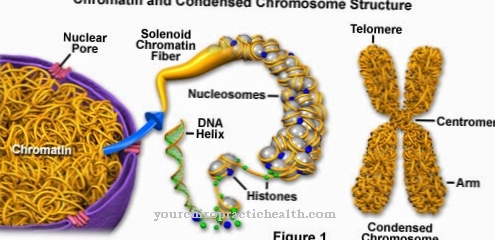The Nasal cavity, also Cavitas nasi, called is created in pairs and is part of the airways. It thus plays an important role in breathing and also houses the olfactory mucosa, which is relevant for the olfactory process.
What is the nasal cavity?
The nose is formed by a bony framework that is supplemented by cartilage plates. The visible parts of the nose include the nostrils, the nasal septum and also the nostrils. The inner part of the nose is however much larger than the outer visible part. It is formed by the nasal cavity (Cavitas nasi). The nasal cavity is bounded at the bottom by the hard palate (palatum durum), which in turn is formed by the maxillary bone and the palatine bone.
The top and back are delimited by the ethmoid bone (os ethmoidale) of the skull base. The nasal cavity closes laterally with the three turbinates, the so-called conchae, which protrude into the nasal cavity. The turbinates enlarge the surface of the mucous membrane of the nose. The choans, paired openings in the nasal cavity, form the transition from the nasal cavity to the pharynx. The paranasal sinuses open into the side passages of the nasal cavity.
The nasal cavity thus forms an almost triangular, pyramidal cavity. This is divided in the middle by the partly cartilaginous, partly bony nasal septum into a right and a left half.
Anatomy & structure
In the nasal cavity, the nasal vestibule, also known as the vestibulum nasi, located inside the outer nose, can be distinguished from the deeper nasal cavity (cavum nasi proprium). The nasal vestibule corresponds approximately to the extension of the nostrils and is lined with multilayered keratinized squamous epithelium. In addition, nasal hairs and small sebum and sweat glands are located in the skin of the vestibule.
At the so-called limen nasi, an arched ridge, is the transition from the nasal vestibule to the nasal cavity. The lining of the nasal cavity also changes here and there is a transition from the multilayered keratinized squamous epithelium to the respiratory epithelium. The respiratory epithelium is also referred to here as the nasal mucosa. It is a skin with many tiny cilia that can transport foreign particles from the air we breathe towards the nasopharynx. Goblet cells ensure the production of mucus and numerous glands ensure that the mucous membrane is moistened.
This area of the mucous membrane is interrupted by a small area that is lined with the olfactory mucous membrane (pars olfactoria). The olfactory mucous membrane is mainly found in the upper nasal concha and measures around 1.3cm² on each side in adults. The nasal mucous membrane is supplied with nerve by the ophthalmic nerve and the maxillary nerve. Accordingly, the blood supply takes place through the arteria ophtalmica and the branches of the arteria maxillaris.
Function & tasks
The nasal cavity has three main functions. On the one hand, it is used to warm, clean and humidify the air we breathe. The mucous membrane of the nasal cavity is primarily responsible for this function. As already mentioned, there are cilia on the surface of the mucous membrane. These hairs move rhythmically in the direction of the nasopharynx and transport small foreign particles such as dust particles.
Goblet cells are embedded between the ciliated epithelium. These produce the slime on which the foreign particles stick. Ciliated epithelium and goblet cells also work together to humidify the air we breathe. The water vapor saturation in the nasal cavity is over 90%. In addition, a plexus of veins in the mucous membrane of the nasal cavity warms the air we breathe. Depending on the temperature of the air you breathe, the small vessels are either widened or narrowed. The colder it is, the stronger the blood flow to the venous plexus and the more the air is heated.
The nasal cavity also fulfills an important function in the smelling process because it houses the olfactory organ. The olfactory cells stored in the olfactory mucous membrane are the cell bodies of the olfactory nerve (olfactory nerve). This rises in many fine fibers through the ethmoid plate into the cranial fossa and transmits its information to the olfactory brain. In addition to these two tasks, the nasal cavity also fulfills a function as a resonance space for the voice.
Diseases
The nasal mucosa is extremely well supplied with blood due to the vein network in the nasal mucosa and a pronounced network of small capillaries at the transition from the nasal vestibule to the nasal cavity. Due to the small structures, the vessels are very fine and therefore sensitive, so that even the smallest injuries can lead to nosebleeds (epistaxis).
Nosebleeds can quickly be caused by breathing air that is too dry or picking the nose. But the cause of the bleeding is not always so harmless. Especially with small children, one should always think of a foreign body in the nose when a nosebleed occurs. An increased tendency to bleed caused by malignant diseases of the blood can also cause nosebleeds. Nosebleeds are often one of the first symptoms of leukemia. The most common disease of the nasal cavity, however, is the simple runny nose, also called rhinitis in technical terms.
Acute rhinitis is usually caused by viruses such as rhinoviruses or adenoviruses. The infection leads to an increased production of nasal secretions, and the patient complains of a "runny nose". The mucous membranes swell, making it difficult to breathe through the nose. In addition, the nasal mucosa is reddened and possibly sore. If nasal breathing is permanently obstructed and nasal secretion is constantly increasing, it is called chronic rhinitis. Chronic rhinitis often leads to chronic sinusitis.
An inflammation of the nasal cavity mucosa can also be caused by allergies. The main symptoms here are also impaired nasal breathing and increased secretion. In addition, there are frequent sneezing attacks and severe itching in the nose.











.jpg)



.jpg)










.jpg)
